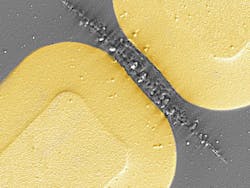BU, MIT, and others show new path to terahertz radiation detectors
Boston, MA--A team of researchers at Boston University (BU), Massachusetts Institute of Technology (MIT), and a number of other institutions have shown that some materials undergo an insulator-to-metal transition under the influence of terahertz radiation.1 The research team achieved a first by demonstrating the use of terahertz light pulses to control the state of matter of a material. In this case, they changed vanadium dioxide (VO2) from an insulating electronic state to a conducting electronic state within a terahertz metamaterial.
According to Harold Hwang, a postdoctoral physical chemist at MIT, electrons moving in a terahertz electric field can gain considerable energy (charges accelerate in an electric field). Says Hwang, “Subpicosecond terahertz pulses can allow us to initiate strong changes in a material. In the case of VO2, the terahertz pulse actually distorts the potential in which electrons lie, freeing them up to make the material a better conductor.” However, to do this requires very strong terahertz fields: In this case, the researchers used split-ring resonators to concentrate the electric field of a terahertz pulse in small areas, increasing the electric field from hundreds of kilovolts per centimeter to about 4 MV/cm.
“Electric fields of this magnitude can drive not only the phase transition in VO2, but also strong nonlinear responses in many different systems,” says Hwang. “This opens the door to high-field terahertz control over electronic and magnetic responses in superconductors, magnetoresistive materials and other correlated electron systems, terahertz-induced ballistic-electron transport in semiconductors, and terahertz-driven structural change in insulating crystals and glasses."
Moving atoms
Hwang adds that, because terahertz frequencies match the resonant frequencies at which neighboring atoms and molecules in crystal lattices vibrate against each other, terahertz pulses can drive the lattice vibrations directly -- possibly to large amplitudes. terahertz light can drive electrons and whole atoms and molecules far from their equilibrium locations in a crystal lattice, which can lead to phase transitions in electronic state and/or crystal structure. This can occur by literally moving the atoms into the positions they occupy in a new crystalline phase. Experimental attempts at terahertz-induced structural phase transitions are currently under way.
The BU and MIT groups and their collaborators have demonstrated the ability to induce a phase transition that changes the conductivity of a VO2 film by two orders of magnitude. Further studies have shown conductivity changes of several orders of magnitude in semiconductors. “This shows a lot of promise in being able to detect terahertz radiation, since the change in conductivity can be read out with conventional electronics,” says Hwang. “We are hopeful that this kind of technology will lead to more sensitive and cheaper terahertz detectors, possibly leading to practical terahertz imaging systems for use in several sectors in industry.”
Source: http://www.newswise.com/articles/researchers-at-bu-mit-demonstrate-terahertz-radiation-can-induce-insulator-to-metal-change-of-state-in-some-materials
REFERENCE:
1. Mengkun Liu et al., Nature 487, 345-348; doi:10.1038/nature11231

John Wallace | Senior Technical Editor (1998-2022)
John Wallace was with Laser Focus World for nearly 25 years, retiring in late June 2022. He obtained a bachelor's degree in mechanical engineering and physics at Rutgers University and a master's in optical engineering at the University of Rochester. Before becoming an editor, John worked as an engineer at RCA, Exxon, Eastman Kodak, and GCA Corporation.
